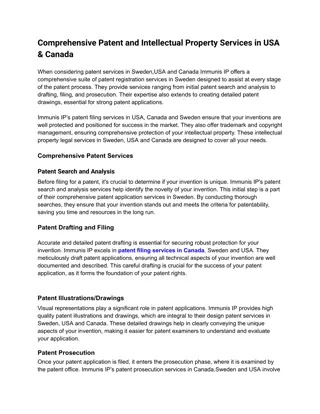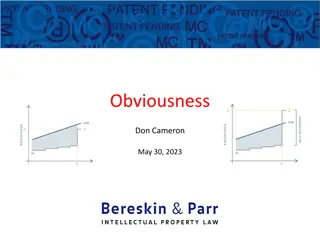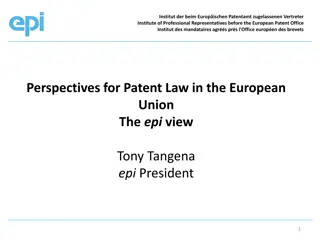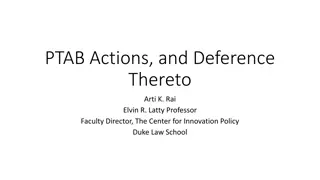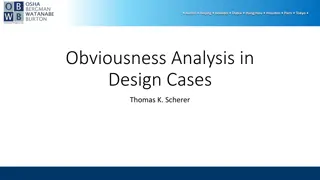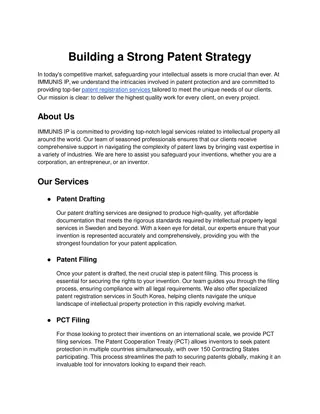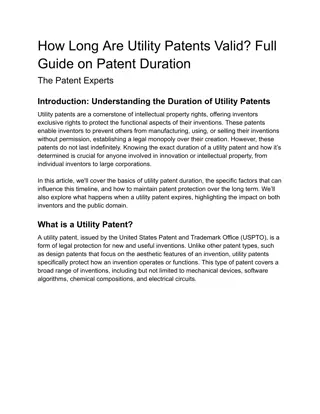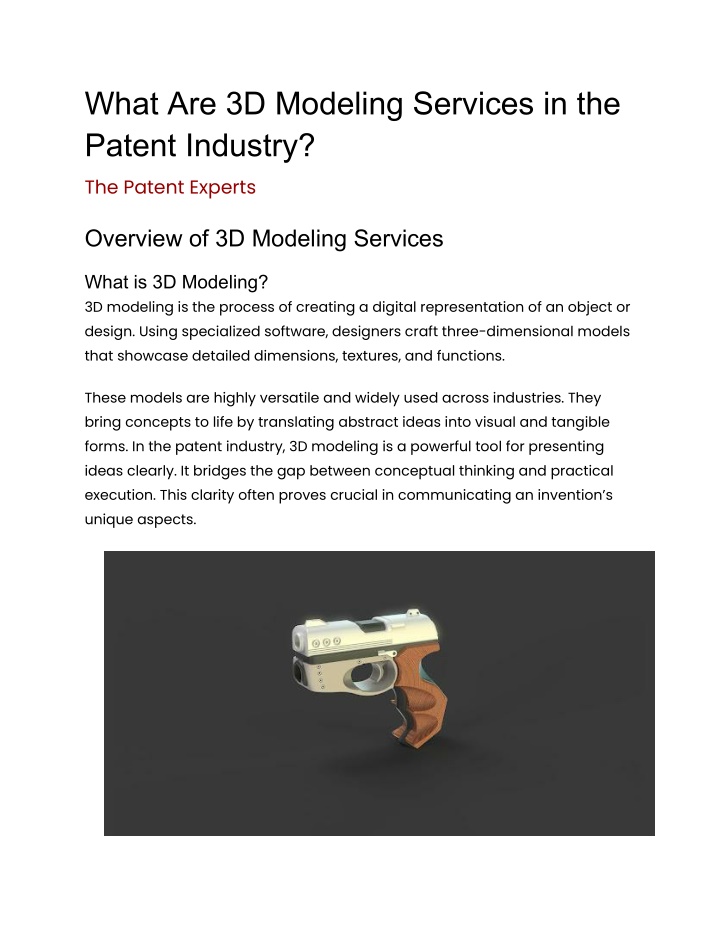
What Are 3D Modeling Services in the Patent Industry? | The Patent Experts
Discover how professional 3D modeling services can transform your ideas into precise, realistic digital models. This blog explores the benefits of 3D modeling across industries like product design, architecture, gaming, and healthcare. Learn about th
Download Presentation

Please find below an Image/Link to download the presentation.
The content on the website is provided AS IS for your information and personal use only. It may not be sold, licensed, or shared on other websites without obtaining consent from the author. If you encounter any issues during the download, it is possible that the publisher has removed the file from their server.
You are allowed to download the files provided on this website for personal or commercial use, subject to the condition that they are used lawfully. All files are the property of their respective owners.
The content on the website is provided AS IS for your information and personal use only. It may not be sold, licensed, or shared on other websites without obtaining consent from the author.
E N D
Presentation Transcript
What Are 3D Modeling Services in the Patent Industry? The Patent Experts Overview of 3D Modeling Services What is 3D Modeling? 3D modeling is the process of creating a digital representation of an object or design. Using specialized software, designers craft three-dimensional models that showcase detailed dimensions, textures, and functions. These models are highly versatile and widely used across industries. They bring concepts to life by translating abstract ideas into visual and tangible forms. In the patent industry, 3D modeling is a powerful tool for presenting ideas clearly. It bridges the gap between conceptual thinking and practical execution. This clarity often proves crucial in communicating an invention s unique aspects.
Moreover, modern 3D modeling tools enable precise simulations of physical properties, which add value to patent applications. For instance, inventors can demonstrate how a product will perform under various conditions, making the concept more compelling. Applications in Various Industries Beyond patents, 3D modeling serves diverse fields. Architecture employs it for creating building plans, enabling architects to visualize structures before construction. The entertainment industry uses it for animations, virtual effects, and video game development. In engineering, it assists in simulating structures, testing designs, and optimizing functionality before manufacturing. In the patent industry, these diverse applications converge. Inventors can leverage 3D models to illustrate their creations effectively, making them indispensable for clear communication and documentation. For example, medical device creators can use 3D models to show intricate designs, while software developers can simulate user interfaces. Importance of 3D Modeling in the Patent Industry Enhancing Patent Applications Patent applications require detailed explanations of an invention. However, written descriptions often fall short in conveying complex ideas. 3D modeling addresses this challenge by providing a visual representation. These models highlight intricate details, functions, and designs. This precision can make a significant difference in how patent examiners understand an invention. Additionally, 3D models help minimize misinterpretations. They provide a universal language that transcends written descriptions, ensuring consistency in communication. For example, a 3D model of a mechanical
device can show moving parts in action, which is difficult to capture through words or 2D drawings alone. 3D modeling also enhances collaboration between inventors, attorneys, and patent examiners. Clear visuals facilitate smoother discussions, reducing the likelihood of misunderstandings and revisions during the application process. Supporting Intellectual Property Litigation In disputes involving intellectual property, clear evidence is critical. 3D modeling helps recreate detailed representations of patented designs or processes. These visual aids are invaluable in court settings. They offer judges and juries a clear understanding of the matter at hand. Moreover, they strengthen arguments by showcasing facts that might otherwise be overlooked in textual descriptions. For example, if a patented product is allegedly infringed upon, a 3D model can compare the original design with the accused product, emphasizing similarities or differences. This level of detail provides compelling evidence, increasing the chances of a favorable outcome. Beyond litigation, 3D models are useful in pre-litigation negotiations. They can help parties visualize the scope of infringement or demonstrate compliance, potentially leading to settlements without court intervention. Benefits of Using 3D Modeling Services Improved Visualization of Concepts 3D modeling transforms ideas into visually engaging representations. This aids inventors by providing a clear view of their designs. Detailed models also
help stakeholders, such as investors or collaborators, grasp the inventions potential. The enhanced visualization fosters better communication and decision-making. For instance, a 3D model can demonstrate the aesthetic appeal of a product while also showing its functional components. Furthermore, these models can be adapted for various purposes, including marketing materials and investor presentations. This versatility adds value beyond the patent application process, helping inventors promote their ideas effectively. Streamlined Patent Approval Process A well-prepared patent application often accelerates the approval process. By integrating 3D models, inventors provide a comprehensive package to examiners. This reduces back-and-forth inquiries and clarifications. As a result, applications are processed more efficiently, saving time and resources. For instance, a detailed 3D model of a medical device can quickly address questions about its functionality, eliminating the need for lengthy explanations. Additionally, 3D models can help identify potential design flaws early, allowing inventors to refine their inventions before submission. This proactive approach improves the quality of the application and increases the likelihood of approval. Choosing the Right 3D Modeling Service Provider Key Considerations When selecting a provider, evaluate their expertise and portfolio. Look for experience in working with patent-related projects. A provider with a proven
track record in intellectual property can offer insights that enhance the quality of your 3D models. The right provider should also demonstrate proficiency in using advanced 3D modeling tools. This ensures high-quality outputs that align with industry standards. Additionally, consider their ability to meet deadlines and communicate effectively throughout the project. Another critical factor is confidentiality. Ensure the provider has measures in place to protect your intellectual property during the modeling process. Questions to Ask a Service Provider Before committing, ask about the provider s experience with intellectual property projects. Request samples of their previous work to assess the quality of their models. It s also essential to discuss timelines and costs upfront. Clear communication helps establish expectations and ensures a smooth collaboration. Inquire about their process for revisions and updates, as flexibility can be crucial in addressing unforeseen changes. Finally, verify whether the provider offers additional services, such as animations or simulations, which can further enhance your patent application. By integrating 3D modeling services, the patent industry gains a powerful ally in visualizing concepts and protecting intellectual property. This technology not only simplifies complex ideas but also enhances the overall process, making it an indispensable tool for inventors and businesses alike. With a careful selection of service providers and strategic use of models, inventors can navigate the patent landscape more effectively. Whether for
applications, litigation, or stakeholder communication, 3D modeling continues to redefine how innovations are presented and protected. Looking for reliable 3D modeling services to support your patent application or intellectual property protection? Partner with experts who understand your needs. Visit The Patent Experts' 3D Modeling Services to bring your ideas to life with precision and professionalism. Enhance your patent process today!


